Tuesday, the final day of Defrag, opened with Andy McAfee of Harvard Business School speaking on the topic of "Enterprise 2.0." I love learning from these Harvard guys. They have such a…delivery, or something. A way of making the topic seem, well, just so compelling and fascinating. They must give these guys stage training. They just keep me forward on the edge of my seat — I love that. Andy referred at one point to his colleague Clayton Christensen, another great thinker and presenter I’ve heard a couple of times. But I must say, after hearing Andy for the first time, he’s in the same category. (An insight of Christensen’s that Andy dropped here, one he also uses as a guidepost, is this: "Managers are voracious consumers of theory.")
"I think we’re at a time parallel to ten years ago," said Andy, "the first stage of the Internet." What he’s been hearing a lot from Corporate America lately is CEOs asking their CIOs, "What is this Web 2.0 thing, and what’s our strategy?" The implication is this trend we’re calling "Enterprise 2.0" is for real, and I guess that’s why it’s a major underlying focus of Defrag.
McAfee put up a slide that he labeled "the knowledge worker’s view of the enterprise." 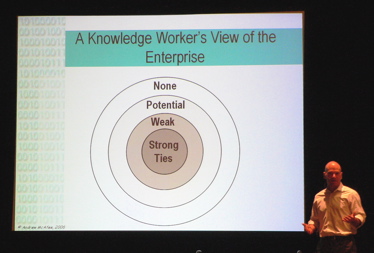
He said this diagram provides a foundation for understanding how the new Web 2.0 technologies help "build ties" in the organization. For the center of the target, "strong ties," the prototypical tool is the wiki. He noted that email is "broken in many ways," and that wiki technology can be a better, simpler solution for collaboration. "I keep coming back to what Ward Cunningham says: ‘What’s the simplest thing we could possibly do?’ "
Andy said that a more important area of focus, however, is the next concentric circle: "weak ties." He quoted a sociologist that says we spend a lot of time working on our strong ties. "That’s okay," said McAfee, "but they’re not likely to be sources of non-redundant info." We need networks to build our weak ties. "That’s exactly what we should be doing inside organizations," he said. "And this speaks to the strength of Facebook inside companies." [I wanted to ask at this point why, then, are some companies banning its use at work? We can only assume they’ll eventually see the light, or create their own internal Facebook-like networks.] "The prototypical tool here is the social newtorking system," said McAfee. "It builds bridges to other networks…and what emerges is access to non-redundant information."
Bloggers Are ‘Brokers’
So, what of the next circle, the "potential ties"? This is the area of the unknown pool of people we all know are out there that we want, or hope to, connect with to expand our worlds. "But how do we find them?" In this classification of ties, Andy said the key is the broker. "Brokers have real value in bridging people." And the prototypical tool here? That, he said, is blogs. You would think he’d be referring to internal company blogs (and Andy does support that practice), but he went beyond what happens inside the firewall. "The blogosphere is an incredible way to expand my knowledge and my network," he said. "And it’s not terribly time intensive. "The typical knowledge worker is not going to spend hours reading blogs, but they can certainly learn how to monitor the most important ones to them." He showed what he called a great example of an internal, idea-sharing blog — that of a construction-related firm called IntraWest. He also spoke of an internal "working prediction market" at Google. FInally, he showed what he said was an excellent example of an intranet, that of Avenue A | Razorfish — and, since we rarely get a glimpse of company intranets as outsiders, I’m including his slide here, at least so you can see the types of information included, if not the detail. 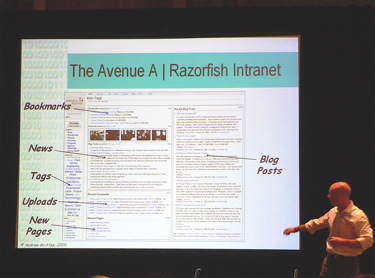
Blog posts receive a prominent position at the right. McAfee said the base technology for this site is MediaWiki. "Companies are deploying technology at all level of the bullseye."
We Need Strangers
But what about that other, final circle — the one McAfee labeled as "None"? Why was it included? He said this is the group that could be assumed to be "people that have nothing to say to each other." But, he said, let’s stop here. "Think about capital markets. This is a way for complete strangers to value a company." And that brought him back to the subject of prediction markets. "There are lots of these on the Internet," said McAfee. "For elections, sports events, many things." He also cited, and showed, the example of the Hollywood Stock Exchange, which is an entertainment prediction market where you can buy, sell, or hold your favorite movies and stars, in a completely virtual marketplace. This was the point where McAfee laid out his greatest challenge. "Why aren’t such markets employed more inside corporations? Especially since firms spend so much time and effort on forecasting. They work!"
Prediction Markets Ascending?
He said he really believes that "we’re missing a play here — it’s worth experimenting." In the discussion following, Andy noted it’s not necessary to have real money at stake in such virtual markets. "Hollywood Stock Exchange is complete funny money." But there are advantages from these markets — "It’s irrelevant if real money is at stake." Google, he said, offers incentives for its employees to participate in its prediction market — specifically t-shirts, which are a very sought after prize inside the firm. "Google employees are not wanting for much," he said, "but I’ve been told there’s a real t-shirt economy going on inside Google." He also noted, in response to a question from an Intuit employee who said her company’s internal blog has cut company email in half(!), that "there’s an authoring urge by certain people, and every company has them." They drive the success of these internal blogs and other tools.
McAfee concluded his talk by saying that this concept of "ties" provides a foundation for understanding how the new Web 2.0 technologies can help create networks between people that would otherwise not form. "Managers want this playbook." He said that some people think the Internet tends to make things "too much alike, too homogenized." But he’s seeing just the opposite. "The net effect of these new Enterprise 2.0 technologies is that they will help companies and workgroups differentiate from each other."
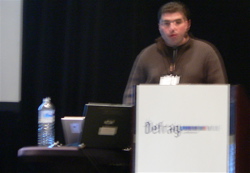 "But the problem is they’re silos," said Alex, "and we don’t own them." Thus, the gist of Alex’s treatise it that we need "Web Wide Attention." The way it stands now, "No single site knows all about me." He said that has to change.
"But the problem is they’re silos," said Alex, "and we don’t own them." Thus, the gist of Alex’s treatise it that we need "Web Wide Attention." The way it stands now, "No single site knows all about me." He said that has to change.
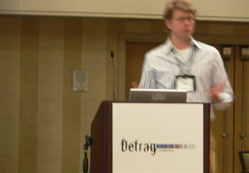
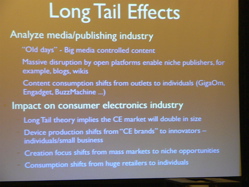 He said later, however, that Bugs Labs’ target audience is only early adopters (and, I would say, only the geeky ones), "by no means mass consumer." Thus, I fail to see how it would really disrupt an entire industry. And no one asked about where product design fits into the equation, once he showed us how the modules snap together, appearing rather kludgey. (He showed CPU, digital camera, LCD, and GPS modules, for example.) It is nonetheless an interesting concept, and Peter did say his firm is seeing a niche market for firms that are now locked into proprietary platforms and have a need to quickly and easily convert to an open platform. He also said they’re seeing interest in the area of home automation.
He said later, however, that Bugs Labs’ target audience is only early adopters (and, I would say, only the geeky ones), "by no means mass consumer." Thus, I fail to see how it would really disrupt an entire industry. And no one asked about where product design fits into the equation, once he showed us how the modules snap together, appearing rather kludgey. (He showed CPU, digital camera, LCD, and GPS modules, for example.) It is nonetheless an interesting concept, and Peter did say his firm is seeing a niche market for firms that are now locked into proprietary platforms and have a need to quickly and easily convert to an open platform. He also said they’re seeing interest in the area of home automation.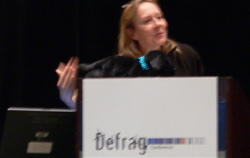
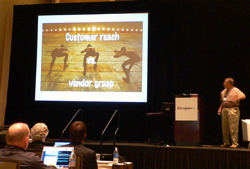 Why is the free market still ‘your choice of silo’?" Doc’s assessment is that the Industrial Age hasn’t ended yet. "And things won’t change till companies stop wanting dependent customers instead of independent ones." He pointed how ridiculous, for example, the customer agreement of Verizon is, which is some 10,000 words. "All this to basically say you have approximately no rights at all." [Love the way with words Doc has.] "In real markets," Doc said,"customers do more than just consume. What if we could help vendors instead of just carp about them? We need to manage our preferences across whole markets." He then went on to describe his
Why is the free market still ‘your choice of silo’?" Doc’s assessment is that the Industrial Age hasn’t ended yet. "And things won’t change till companies stop wanting dependent customers instead of independent ones." He pointed how ridiculous, for example, the customer agreement of Verizon is, which is some 10,000 words. "All this to basically say you have approximately no rights at all." [Love the way with words Doc has.] "In real markets," Doc said,"customers do more than just consume. What if we could help vendors instead of just carp about them? We need to manage our preferences across whole markets." He then went on to describe his 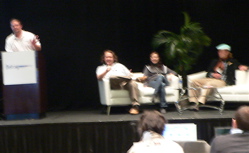
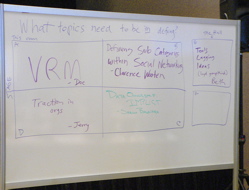
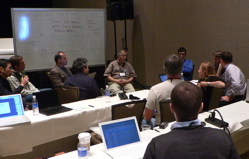

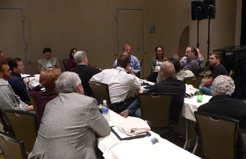

Recent Comments